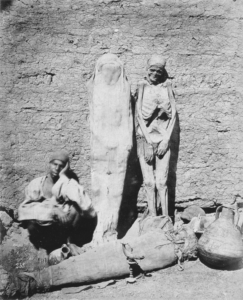For years, mummies were a commodity. Beginning in the sixteenth century, Europeans used mummy dust (as in real, actual, ground-up human corpse) as a medication to cure just about everything, and the pigment mummy brown was the color of dry, dusty corpses because it was literally made of dried, dusty corpses. Despite being an extraordinarily macabre commodity, there was still demand for mummy dust, so much so that a trade in counterfeit mummies (that is, bodies that had been dried out and treated with bitumen) sprung up, and the recently dead sold alongside ancient corpses.
As a pigment, mummy brown was easy to work with, but prone to fading and cracking. It remained available until the 20th century, and modern versions of the color are made of minerals rather than corpses. Mummy dust and mummy parts also remained available for purchase until the middle twentieth century, though mostly in curiosity and oddity shops. The photo below shows a mummy seller in 1875, when mummy brown and medicinal mummy dust would have been on the wane.
Related Links:
The Life and Death of Mummy Brown from the Journal of Art in Society
The Gruesome History of Eating Corpses as Medicine from Smithsonian
Mummy Brown and Other Historical Colors from the always-delightful Veritable Hokum
Podcast: Play in new window | Download
Subscribe: RSS
